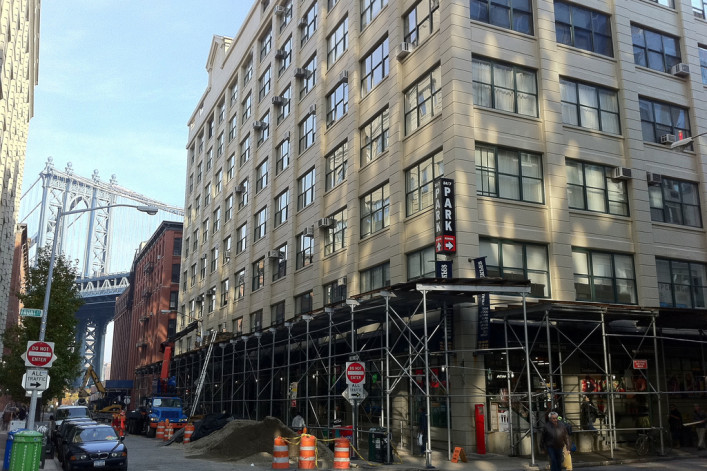Here's why you see scaffolding all over NYC

New Yorkers may have a lot of pet peeves, but scaffolding (known in the business as "sidewalk sheds") has to be rather high up on that list.
That's because scaffolding has seemingly been everywhere for the past few years, turning sidewalks into mazes and tunnels, blocking off light, hurting businesses whose facades are obstructed by it, and creating potential safety hazards.
This isn't a new complaint, either; back in 2011, we reported on the ire that bubbled up online about the proliferation of scaffolding in the city, with one Streeteasy poster observing: "It's the weirdest look, the permanent scaffolds on almost every block." And the apparent scourge continues.
Crain's New York recently took a very close look into the booming scaffolding business, which, per the article, "generates $1 billion a year—$200 million of that is for the street-level sheds, and the rest pays for the scaffolding and the workers who repair the façades." According to the magazine, there are almost 9,000 sheds along city streets -- that's 190 miles of sheds -- up from around 3,500 in 2003.
WHY THEY'RE EVERYWHERE
The current construction boom is partly responsible for the ubiquity of scaffolding, but it can also be traced back to the city's Local Law 11, which requires owners of buildings taller than six stories to have their facades checked every five years to make sure there are no loose bricks or loose masonry, at which point scaffolding is erected.
Local Law 11 (and its predecessor, Local Law 10) was created after a falling brick killed a young woman in 1979. Railings were added to the checklist after a 35-year-old woman was killed when a balcony railing collapsed in 2013.
And, Crain's reports that cautious city officials will sometimes require sidewalk sheds for minor projects that don't necessarily need them. "One reason is constrained resources: The Department of Buildings' 500 inspectors monitor thousands of construction sites, and harried officials sometimes order a shed to protect pedestrians until they get time to visit the building."
WHAT GOES UP MUST COME DOWN, RIGHT?!
The problem is that once scaffolding goes, there's no law saying private landlord have to take them down (which explains why one Harlem block has had scaffolding for over 10 years).
Crain's explains the math: "To erect a 200-foot-long shed costs around $25,000, half of which is paid upfront and the rest when the shed is taken down. In between, the shed builder collects about $700 per month in rent" (which is low for private landlords)." Dormant sheds must be taken down on public housing property, Crain's reports, but private landlords don't have any such rules.
If a shed is up near you, and work seems to have ceased, you can file a complaint with the Department of Buildings, which issues the permits for scaffolding, by calling or visiting 311 online.
If your entire building is being adversely affected, you can consider banding together with other renters or co-op owners and filing a lawsuit against the building with the permit for scaffolding, says attorney Jerry Feeney.
THE LOOK—AND WHAT'S IN STORE
Since 2013, the city has mandated a hunter green color for all sheds, and has begun allowing advertisements.
Through the years, the city has called architects to design alternative, more attractive sheds, reports the New York Times, but builders seem reluctant, saying they're either too expensive or take up too much space.
Feeney, who says he "hates" scaffolding and often finds himself crossing the street so as not to walk under the steel beams that are part of the sheds, has some improvements in mind . "First off, I think they should coordinate Local Law 11 work by block, so that it's all done at once every five years." And, Feeney says, New York should follow the lead of other cities that use drones to inspect the buildings and have certified engineers report back on any work that needs to be done, rather than erecting scaffolding and then checking.
"We need to move out of the dark ages. Twenty years ago, we didn't have drones so we had to use this ugly scaffolding, but we don't anymore."
He also believes buildings should have to pay a penalty for every day past a certain amount of time that a shed is left up. "It's a real problem," he says. "Besides being ugly and dangerous, it also impacts the market value of an apartment. People don't want to rent or buy an apartment when the building is covered in scaffolding ad infinitum."
Related:
When scaffolding overstays its welcome (for an entire decade)
Is the city being held hostage my scaffolding?
The dangers of falling bricks are not just physical
Inside story: my eternity in scaffolding
Is the city being held hostage by scaffolding?
Do renters deserve a discount for scaffolding?
























